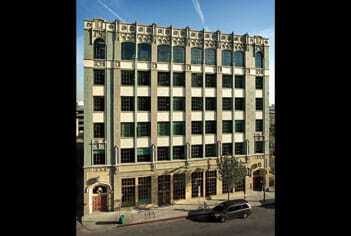| The poured -in-place concrete building not only had its ornamental facade and original windows, but also a few original interior features-in particular, impressive mushroom-cap structural columns and high ceilings. These formed the core for the reuse.. |
The Downtown Women’s Center (DWC), the only organization that has been exclusively dedicated to serving homeless women in Los Angeles’s skid row for more than 30 years, had outgrown its original facility. The center was founded in 1978 by pioneering social worker Jill Halverson when she befriended a homeless woman named Rosa. Halverson and community leaders started the center in a building on Los Angeles Street, and it grew into a nationally renowned nonprofit serving homeless and very-low-income women. By 2005, the original building was bursting at the seams and, with the changing nature of downtown real estate, new development was pressing against it.
Interested in both accommodating new residents and continuing to serve the homeless and disadvantaged, the Los Angeles Community Redevelopment Agency looked for a solution. It offered DWC a vacant, somewhat dilapidated six-story building a few blocks away. While the price tag was only one dollar, the rehabilitation cost would be $26 million. Never ones to shy away from a challenge, the DWC board and staff began a fundraising campaign. With the support of public and private donors and the leadership of Mayor Antonio Villaraigosa and council member Jan Perry, the organization assembled a complex package of government funds and grants, and private donations.
The new location has a story. The Renaissance Building, as it was sometimes known, was built in 1927 by Florence C. Casler, a partner in the construction firm Casler and Lloyd and one of the few women in the country building high rises at the time. One of the building’s early tenants was the Elias Katz Shoe Company. It is fitting that the building would cycle back to female ownership in its latest incarnation.
Eligible for listing in the National Register of Historic Places, the building is noted both for its architectural significance and as emblem of downtown’s rise as a commercial and manufacturing center of the early 20th century. The detailed Gothic revival facade is exemplary of the craftsmanship and character of the era. At first glance, the task was more than a bit daunting. The building is six stories of cavernous open floors with huge supporting columns and industrial windows that had not been opened in decades. It was sturdy, but not inviting. The ornate facade was in need of restoration; its signature elements—windows, ornament, and cladding materials—were deteriorating. The list of upgrades to make the building a home began to mount.
Local architecture firm Pica + Sullivan Ltd., with Maureen Sullivan as the lead architect, assembled an all-female design team known for bringing historic buildings back to life. The first step was identifying the condition of the historic materials and features to be retained. The poured-in-place concrete building not only had its ornamental facade and original windows, but also a few original interior features—in particular, impressive mushroom-cap structural columns and high ceilings. These formed the core for the reuse.
The building had “good bones,” but was in need of substantial upgrades for housing. A sensitive seismic retrofit, code upgrades for accessibility, state-of-the-art fire and life safety systems, and new heating, ventilation, and air-conditioning and electrical components were blended into historic spaces. The team and the DWC board also wanted a high degree of sustainability both through the reuse of materials and new components. Through their efforts, the building was awarded a Silver certification under the Leadership in Energy and Environmental Design (LEED) program and a National Preservation Award by the National Trust for Historic Preservation.
The 71 residential units, each with a private bath and kitchenette, are filled with light. The ground floor houses a day center that homeless women can visit to receive services, and a retail store that showcases products made by the women.


![starland tour pic[1].jpg](https://cdn-ul.uli.org/dims4/default/6af5ee3/2147483647/strip/true/crop/800x450+0+42/resize/500x281!/quality/90/?url=https%3A%2F%2Fk2-prod-uli.s3.us-east-1.amazonaws.com%2Fbrightspot%2F1b%2Fb5%2Faedcc97041ea90be6b29e2565d53%2Fstarland-tour-pic1.jpg)


